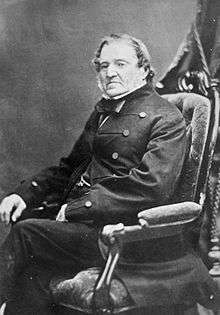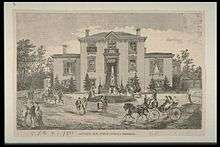Frédéric-Auguste Quesnel
Frédéric-Auguste Quesnel, KC (February 4, 1785 – July 28, 1866), was a Canadien lawyer, businessman and politician. He held a number of public offices and in politics he was a moderate who represented Chambly in the Legislative Assembly of Lower Canada (1820-1834); and Montmorency in the Legislative Assembly of the Province of Canada (1841-1844 & 1848-1866). From 1837 to 1841 he sat on the Executive Council of Lower Canada. Condemned by the Patriotes as a vendu in the Lower Canada Rebellion, in 1860 he was elected President of the Saint-Jean-Baptiste Society. In 1859, he was elected President of the Banque du Peuple and his achievements in commerce and finance served to show that a French Canadian could make his fortune in business.[1] His home, Manoir Souvenir (now a ruin) was one of the early estates of the Golden Square Mile.
Frédéric-Auguste Quesnel | |
|---|---|
 | |
| Member of the Legislative Assembly of Lower Canada for Chambly | |
| In office 1820–1834 | |
| Member of the Executive Council of Lower Canada | |
| In office 1837–1841 | |
| Member of the Legislative Assembly of the Province of Canada for Montmorency | |
| In office 1841-1844–1848-1866 | |
| Personal details | |
| Born | February 4, 1785 Montreal, Quebec |
| Died | July 28, 1866 (aged 81) Montreal, Quebec |
| Nationality | Canadien |
| Political party | Moderate |
| Residence | Manoir Souvenir, Square Mile |
| Alma mater | Collège Saint-Raphaël |
Early life
In 1785, Quesnel was born at Montreal into a family well known in Canadien gentry society. He was the eldest son of Joseph Quesnel and Marie-Josephte Deslandes, step-daughter of Maurice-Régis Blondeau. His brothers included The Hon. Jules-Maurice Quesnel, a member of the Beaver Club, and his sister was married to The Hon. Côme-Séraphin Cherrier. Like all his brothers, he was educated at the Collège Saint-Raphaël from 1796 to 1803. Afterwards, he articled in the law offices of Stephen Sewell, and could speak both French and English fluently.
Early career
He was admitted to the Bar of Montreal in 1807, set up practice there, and by 1819 had offices on Rue Notre-Dame. During that period, Quesnel laid the basis of his fortune by investing in his brother's, Jules-Maurice's, activities in the fur trade. He was also involved in various speculations that included considerable land sales. Already a Captain in the 5th Battalion of Montreal militia, this unit became the Chasseurs Canadiens with whom he fought during the War of 1812. Sometime after the war, he reached the rank of Major.
Politics
From 1820 to 1834, Quesnel represented Kent County, which in 1829 was renamed Chambly, in the Legislative Assembly of Lower Canada, gaining a reputation as an elegant speaker.[2] In the early years, he supported Louis-Joseph Papineau and Denis-Benjamin Viger. In 1822, he voted against the proposed union of Upper and Lower Canada.
Quesnel was a moderate, which made his position increasingly difficult as Papineau became more radical. After several stands against him and his supporters, the final break for Quesnel came over the Ninety-Two Resolutions. He stated: "to say in a few words what I think of them, I approve a great many, I reject several, but taken as a whole and as a single unit, I cannot approve them".[3] Quesnel backed John Neilson's attempt to introduce more moderate resolutions, but both men were condemned at a public meeting at Saint-Athanase-d’Iberville and lost their seats to supporters of Papineau.
As the political situation in Lower Canada worsened by 1837, with Clément-Charles Sabrevois de Bleury and George Moffatt, Quesnel arranged a public meeting at Montreal in support of the government. Two months later, Lord Gosford appointed him to the Executive Council of Lower Canada. When the Lower Canada Rebellion broke out, Quesnel was condemned as a vendu by the Patriotes and his brother, Joseph-Timoléon, was forced to flee L’Acadie and give up his magistrate’s commission.
In 1840, Quesnel headed a delegation still opposing the union of Upper and Lower Canada. When the Canadas did unite the following year, he was elected to the Legislative Assembly of the Province of Canada for Montmorency. Lord Sydenham listed as Quesnel as one of the members who consistently voted against him. Fearing he might support the Tory government under pressure from Denis-Benjamin Viger, he was defeated in the 1844 elections. Four years later, he was re-elected and held the seat until his death in 1866.
Public life
In 1831, he was named King's Counsel. He supported the 1849 Rebellion Losses Bill and opposed annexation to the United States; he ensured that proper compensation for seigneurs was built into legislation to abolish seigneurial tenure. Quesnel was elected president of the Saint-Jean-Baptiste Society of Montreal in 1860.
Business
Quesnel was one of only a few Canadiens of his generation to enter into business life, and he made a fortune doing so. Having been involved in land speculation from the earliest days of his career, by 1864 he was reaping the awards of these early investments: He sold the land which would become Sainte-Cunégonde to William Workman and Alexandre-Maurice Delisle for $100,000. In 1843, the Banque du Peuple was born through the Quebec Nationalist movement, to cater for French Canadians, and in 1848 Quesnel was made a director. He served as its president from 1859 to 1865, during which time the bank enjoyed steady growth and tranquillity. Long after Quesnel's death, in 1894 mismanagement at a time of Montreal's economic peak wrecked it, and the bank was eventually forced to close its doors the following year.[4]
Family

In 1830, within a park of 240 acres, Quesnel built Manoir Souvenir, one of the early estates of the Golden Square Mile and so named in memory of his wife. In 1813, at Boucherville, Quesnel married Marguerite Denaut (1791-1820), the only daughter and heiress of Captain Joachim Denaut, a wealthy fur trader who lived at Granville, by his wife Marguerite Chabert. She died in 1820, and their two sons and three daughters all predeceased him too. He adopted a nephew, and one son married and left a daughter.
- Pierre-Adolphe-Augustin Quesnel. In 1843, at Boucherville, he married Charlotte Vercheres-Boucher de Boucherville, granddaughter of The Hon. René-Amable Boucher de Boucherville and niece of The Hon. Louis-René Chaussegros de Léry. Their daughter, Emma, married The Hon. Théodore Robitaille, 4th Lieutenant Governor of Quebec.
- The Hon. Charles-Joseph Coursol was the son of Quesnel's sister, Marie-Melanie, and after his father (Michel Coursol) died when Charles-Joseph was only one year old, Quesnel adopted him. He married a daughter of The Hon. Sir Étienne-Paschal Taché and inherited the bulk of Quesnel's estate, including Manoir Souvenir. They were the parents of four children.
See also
- List of Presidents of the Saint-Jean-Baptiste Society of Montreal
References
External links
- "Frédéric-Auguste Quesnel". Dictionary of Canadian Biography (online ed.). University of Toronto Press. 1979–2016.
- "Biography". Dictionnaire des parlementaires du Québec de 1792 à nos jours (in French). National Assembly of Quebec.